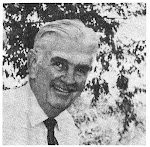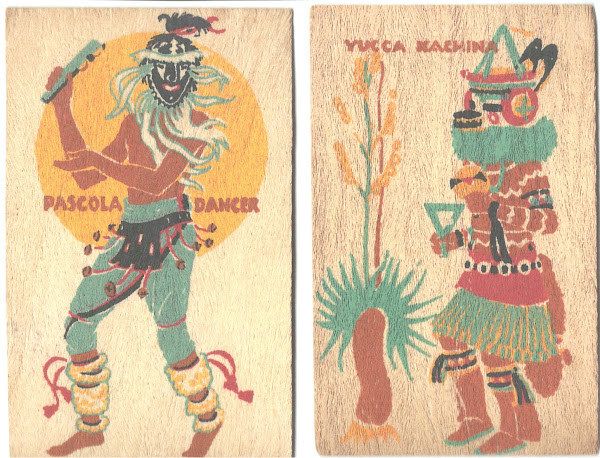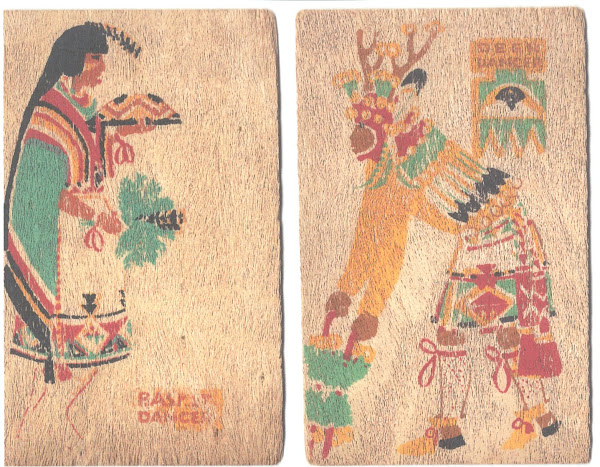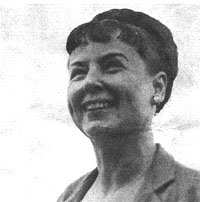Joan Hoffman passed along this copy of a photo that appeared in the Seattle Times Aug. 19, 1939. This picture and a short article noted that they were in town and nearing the end of their North America trip. (Nothing about the cat.)
Joan has been arduous in tracking down Hoffman memorabilia and ephemera. She wrote, “I liked the photo and didn't have many pictures of them at that age. They are a nice looking couple. The information on the back only confirmed that they were at Seattle in August of 1939.” She notes that this eBay purchase took seven weeks after “being lost in the archives.”
She mentions, “I guess the attraction was that Holling was an author and they were illustrators. Holling's books were for children, but they didn't have any children of their own. Travel with a trailer during the Depression was perhaps not all that common. They were in search of material and having a good time.”
Not the most exciting news break, but during the dog days of summer there's a dearth of news.
She continues, “One of the things said was that they had already traveled 31,000 miles. Hinman in her thesis said they traveled over 100,000 miles. From Seattle, they traveled to California and that was the end of the trip. It wouldn't have taken another 69,000 to get to Calif. That's quite a difference.”
None of Holling's books were mentioned in the article.
Wednesday, March 6, 2013
Sunday, March 3, 2013
Amanuensis (Not)
Lucille Webster Holling has gotten short shrift. These sympathies may be misplaced because during the early part of the last century many women found their natural talents hidden under their husbands’ fame. In politics, they were the Mamie Eisenhowers and Pat Nixons. Among children’s book writers, it may have been Lucille who toiled in the shadows.
I needed to know more Lucille’s work, particularly since I’ve been captivated by her art apart from Holling’s books. Lucille was not an amanuensis, at her master's personal service. She was a collaborator.
As I wrote in this blog last year, Lucille was born on Dec. 8, 1900, in Valparaiso, Ind. In Chicago, she designed theatrical scenery and costumes, and she drew for fashion publications.
Joan Hoffman writes, “It is my impression that Lucille's art interest was in art fashion. She attended some classes at the Art Institute of Chicago, but I don't believe she finished a program there.”
A mutual friend introduced Holling to Lucille and her sister who had an art studio in the city. Lucille remembers sharing a nice date at a Chinese restaurant, but it wasn’t until she attended the Art Institute the following year that Holling was re-introduced to Lucille during one of the girls’ open houses. That night, Holling and Lucille planned a world tour and began seeing each other steadily.
While Holling grew up in rural Michigan in a large family of devoted Methodists, Lucille was in some ways his opposite. She was a city girl whose father and a baby brother died early. There was no apparent religious observance, although her personal Bible is among UCLA’s archives. She had the one older sister, mentioned earlier, who was also an artist but unstable.
Joan Hoffman reflects, “I'm not sure that Lucille regretted her choices. The one thing she seemed to have regretted in later life was Holling's referring to home as the time back in Michigan growing up and not the home she made for him. Holling reflected a lot on his early life in letters to family. That has been a plus for me; it has given me a rich source for that period in his life that would not otherwise have been available.”
Still, they were married in 1925. The following year, the couple went on the first University World Cruise, where she designed for the drama department.
Joan Hoffman notes that Lucille made specific contributions to two Houghton Mifflin books. In Pagoo all those microscopic drawings are hers and her name appears along with Holling's as illustrator on the title page. In the acknowledgment for Tree in the Trail, Holling gives Lucille credit for helping to complete the illustrations, research trail data and design the colored map at the end.
Aside from Holling’s books she illustrated, one painting stands out. A bi-plane over the coast of Hawaii was completed in 1928. Kimo, written by Alice Cooper Bailey and illustrated by Lucille, tells the story of young boy whose grandmother was the doomed Queen of Hawaii. The biplane was used to bring long parted members of the royal family back together, who had been living on two different islands following the American takeover of the islands
Lucille went on to illustrate The Book of Indians (1935). Choo-Me-Shoo (1928), and Children of Other Lands (1933) by Watty Piper. There were also postcards of Indian dancers (1941), six full color illustrations done by Lucille when she and her husband undertook an assignment in Texas. These are like the Indian dancers [Holling] painted at the new Hilton Hotel in Lubbock, Texas, at the end of 1929. Holling has reportedly said Lucille “drew women and children better than I do.”
While Lucille’s work gets less recognition than her husband’s, the partnership and collaboration made each other’s work greater than they might have been apart.
 |
Bi-plane over the coastline of Hawaii (1928), a vivid plein air painting.
|
Lucille Webster Holling has gotten short shrift. These sympathies may be misplaced because during the early part of the last century many women found their natural talents hidden under their husbands’ fame. In politics, they were the Mamie Eisenhowers and Pat Nixons. Among children’s book writers, it may have been Lucille who toiled in the shadows.
I needed to know more Lucille’s work, particularly since I’ve been captivated by her art apart from Holling’s books. Lucille was not an amanuensis, at her master's personal service. She was a collaborator.
As I wrote in this blog last year, Lucille was born on Dec. 8, 1900, in Valparaiso, Ind. In Chicago, she designed theatrical scenery and costumes, and she drew for fashion publications.
Joan Hoffman writes, “It is my impression that Lucille's art interest was in art fashion. She attended some classes at the Art Institute of Chicago, but I don't believe she finished a program there.”
A mutual friend introduced Holling to Lucille and her sister who had an art studio in the city. Lucille remembers sharing a nice date at a Chinese restaurant, but it wasn’t until she attended the Art Institute the following year that Holling was re-introduced to Lucille during one of the girls’ open houses. That night, Holling and Lucille planned a world tour and began seeing each other steadily.
While Holling grew up in rural Michigan in a large family of devoted Methodists, Lucille was in some ways his opposite. She was a city girl whose father and a baby brother died early. There was no apparent religious observance, although her personal Bible is among UCLA’s archives. She had the one older sister, mentioned earlier, who was also an artist but unstable.
Joan Hoffman reflects, “I'm not sure that Lucille regretted her choices. The one thing she seemed to have regretted in later life was Holling's referring to home as the time back in Michigan growing up and not the home she made for him. Holling reflected a lot on his early life in letters to family. That has been a plus for me; it has given me a rich source for that period in his life that would not otherwise have been available.”
Still, they were married in 1925. The following year, the couple went on the first University World Cruise, where she designed for the drama department.
Joan Hoffman notes that Lucille made specific contributions to two Houghton Mifflin books. In Pagoo all those microscopic drawings are hers and her name appears along with Holling's as illustrator on the title page. In the acknowledgment for Tree in the Trail, Holling gives Lucille credit for helping to complete the illustrations, research trail data and design the colored map at the end.
Aside from Holling’s books she illustrated, one painting stands out. A bi-plane over the coast of Hawaii was completed in 1928. Kimo, written by Alice Cooper Bailey and illustrated by Lucille, tells the story of young boy whose grandmother was the doomed Queen of Hawaii. The biplane was used to bring long parted members of the royal family back together, who had been living on two different islands following the American takeover of the islands
Lucille went on to illustrate The Book of Indians (1935). Choo-Me-Shoo (1928), and Children of Other Lands (1933) by Watty Piper. There were also postcards of Indian dancers (1941), six full color illustrations done by Lucille when she and her husband undertook an assignment in Texas. These are like the Indian dancers [Holling] painted at the new Hilton Hotel in Lubbock, Texas, at the end of 1929. Holling has reportedly said Lucille “drew women and children better than I do.”
While Lucille’s work gets less recognition than her husband’s, the partnership and collaboration made each other’s work greater than they might have been apart.
Subscribe to:
Posts (Atom)









